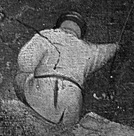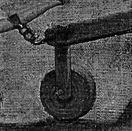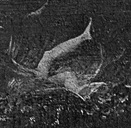Marius V. Peelen and Sabine Kastner, ‘Attention in the Real World: Toward Understanding its Neural Basis’, Trends in Cognitive Sciences, 18 (2014), 242-50.
The problem identified in this paper is important, and versions of it have already appeared in this blog. Peelen and Kastner argue that many experiments on visual attention and perception use artificial arrays in the laboratory. The data that result from tests with shapes and colours on plain backgrounds tell us a lot about human perception, but may well obscure the ways we have evolved to see things in the real world. In this paper the authors present evidence of special characteristics of the ways attention operates in our usual cluttered visual fields, and proposals for further study.
I’ve come across this issue in other forms. In an essay about how ‘’, my colleague Greg Davis and his collaborators devised what they call ‘an elaborate deception procedure’. They wanted to test participants with the same stimulus each time, but ideally they wanted them to respond as if the person they were watching was live and present. Thus they told the participants that they were watching a video link from an adjoining room. This was a way of achieving a balance between live-action presence and the need for consistency in the experiment.
Peelen and Kastner propose that our experience in dealing with familiar situations gives us ‘templates’ with which to navigate the visual world. The task of identifying a person in a complex picture is different – and proves easier – than picking out a particular abstract shape. Their idea is that we have these templates, which quickly limit our attention, so as to ensure we do not miss the most important things. These ‘what-templates’ and ‘where-templates’ direct us to locations and shapes that are likely to reveal the things we need to see. Further research is necessary, they say, to reveal more about this real-world performance.
The general point – that the narrowing and abstraction probably obliged by the need for experimental clarity risk obscuring things about how cognition operates – is valuable. Specifically, it made me think about stage directions. These are one indication of how the visual array presented by a play will work. Many great plays have very few stage directions, and leave a great deal for directors and designers to do. However, many others suggest meticulous attention to how the human beings involved will stand out against the environment, and how objects in that environment will become meaningful for us. They are rarely realistic in the sense that Peelen and Kastner are exploring, but they engage our real-time responses to human figures and the things around them.
Beckett’s Waiting for Godot starts with a spare description of the scene in general, and a couple of very specific points:
A country road. A tree.
Evening.
Estragon, sitting on a low mound, is trying to take off his boot. He pulls at it with both hands, panting.
One thing to note about stage directions is that they are rarely just plain instructions to follow. To say this is a ‘country road’ may be a description of the first performances, or an outline for all future performances, but it leaves open the question of how a country road it to be realised. With some trees on the background? Perhaps, but this would compromise the significance of the one tree mentioned. With a road sign showing a cow or a tractor? Clearly not. Perhaps the important thing is that the actors know it’s a country road and inflect their performances accordingly. There is more information in Act 2:
Next day. Same time.
Same place.
Estragon’s boots front center, heels together, toes splayed.
Lucky’s hat at same place.
The tree has four or five leaves.
Enter Vladimir agitatedly. He halts and looks long at the tree, then suddenly begins to move feverishly about the stage. He halts before the boots, picks one up, examines it, sniffs it, manifests disgust, puts it back carefully. Comes and goes. Halts extreme right and gazes into distance off, shading his eyes with his hand. Comes and goes. Halts extreme left, as before. Comes and goes. Halts suddenly and begins to sing loudly.
It would be hard to argue that this scene has been composed thoughtlessly. Characters and objects are disposed in a way that affects how things are perceived and attended to. It is not easy to say what the effect would actually be; indeed, in the case of Waiting for Godot the search for some sort of packaged, meaningful effect may be futile.
There are many modern dramatists whose stage directions are far more elaborate than this, constructing scenes with realistic qualities and a great deal of managed significance. Tennessee Williams and Arthur Miller would be good examples. Lengthy descriptions in novels might well be open to similar scrutiny, although it’s not straightforward that we translate them into pictures and attend to them using anything like the visual systems discussed by Peelen and Kastner. Still, when we are interested in how the human emerges from the environment, as they are, then the way that fields or factories are described will interact with our capacity – our need – to find the human and account for it. Paintings, too, could be thought of in the same way. Bruegel’s complex scenes, with the significant figures sometimes hard to find, come to mind.
I tend to think that drama might work a bit like the ‘deception procedure’ described above, hitting a compromise by enabling control and consistency in what experimental subjects see, while also ensuring that there is something like a live-action impression. This means I think that it might be possible for a play might be considered as a kind of data for explorations of perception and attention. However, I think it’s important to recognise that a play (or a novel or a painting) interacts actively with the questions the scientists are asking, about how we see things in the real world. Literature is based on experience, knowledge, and theories, of how we perceive and attend, and I don’t see why it can’t offer valuable ideas of its own.


